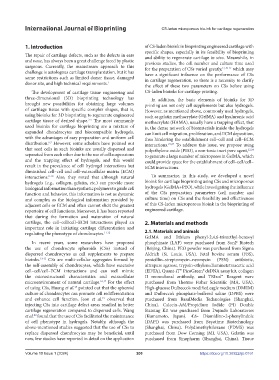Page 208 - IJB-10-1
P. 208
International Journal of Bioprinting CS-laden microporous bio-ink for cartilage regeneration
1. Introduction of CS-laden bioink in bioprinting engineered cartilage with
specific shapes, especially in its feasibility of bioprinting
The repair of cartilage defects, such as the defects in ears and ability to regenerate cartilage in vivo. Meanwhile, in
and nose, has always been a great challenge faced by plastic previous studies, the cell number and culture time used
surgeons. Currently, the mainstream approach to this for the preparation of CSs varied greatly, 17,19-21 which may
challenge is autologous cartilage transplantation, but it has have a significant influence on the performance of CSs
some restrictions such as limited donor tissue, damaged in cartilage regeneration, so there is a necessity to clarify
donor site, and high technical requirements. 1
the effect of these two parameters on CSs before using
The development of cartilage tissue engineering and CS-laden bioinks for cartilage printing.
three-dimensional (3D) bioprinting technology has In addition, the basic elements of bioinks for 3D
brought new possibilities for obtaining large volumes printing are not only cell supplements but also hydrogels.
of cartilage tissue with specific complex shapes, that is, However, as mentioned above, commonly used hydrogels,
using bioinks for 3D bioprinting to regenerate engineered such as gelatin methacrylate (GelMA) and hyaluronic acid
cartilage tissue of desired shape. The most commonly methacrylate (HAMA), usually have a trapping effect, that
2-5
used bioinks for cartilage bioprinting are a mixture of is, the dense network of biomaterials inside the hydrogels
expanded chondrocytes and biocompatible hydrogels, can limit cell migration, proliferation, and ECM deposition,
with the advantages of easy preparation and uniform cell thus hindering the establishment cell–cell and cell–ECM
distribution. However, some scholars have pointed out interactions. 22,23 To address this issue, we propose using
6,7
that seed cells in such bioinks are usually dispersed and polyethylene oxide (PEO), a non-toxic inert pore agent, 23,24
separated from each other due to the use of cell suspensions to generate a large number of micropores in GelMA, which
and the trapping effect of hydrogels, and this would could provide space for the establishment of cell–cell/cell–
result in the prevalence of cell–hydrogel interactions but ECM interactions.
diminished cell–cell and cell–extracellular matrix (ECM)
interactions. 8-10 Also, they noted that although natural To summarize, in this study, we developed a novel
hydrogels (e.g., collagen, gelatin, etc.) can provide more bioink for cartilage bioprinting using CSs and microporous
biological information than synthetic polymers to guide cell hydrogels (GelMA+PEO), while investigating the influence
function and behavior, this information is not as dynamic of the CSs preparation parameters (cell number and
and complex as the biological information provided by culture time) on CSs and the feasibility and effectiveness
adjacent cells or ECM and often cannot elicit the greatest of this CS-laden microporous bioink in the bioprinting of
repertoire of cell functions. Moreover, it has been reported engineered cartilage.
that during the formation and maturation of natural
cartilage, the cell–cell/cell–ECM interactions played an 2. Materials and methods
important role in initiating cartilage differentiation and
regulating the phenotype of chondrocytes. 11,12 2.1. Materials and animals
GelMA and lithium phenyl-2,4,6-trimethyl-benzoyl
In recent years, some researchers have proposed phosphinate (LAP) were purchased from SunP Biotech
the use of chondrocyte spheroids (CSs) instead of (Beijing, China). PEO powder was purchased from Sigma
dispersed chondrocytes as cell supplements to prepare Aldrich (St. Louis, USA). Fetal bovine serum (FBS),
bioinks. 13-15 CSs are multi-cellular aggregates formed by penicillin–streptomycin–neomycin (PSN) antibiotic,
the self-assembly of chondrocytes, which have extensive ultrapure agarose, trypsin-ethylenediaminetetraacetic acid
cell–cell/cell–ECM interactions and can well mimic (EDTA), Quant-iT™ PicoGreen® dsDNA assay kit, collagen
the microstructural characteristics and extracellular II monoclonal antibody, and TRIzol™ Reagent were
microenvironment of natural cartilage. 16,17 For the effect purchased from Thermo Fisher Scientific (MA, USA).
of using CSs, Huang et al. pointed out that the spheroid High-glucose Dulbecco’s modified eagle medium (DMEM)
18
culture of chondrocytes can promote cell redifferentiation and Dulbecco’s phosphate-buffered saline (DPBS) were
and enhance cell function. Jeon et al. observed that purchased from BasalMedia Technologies (Shanghai,
19
injecting CSs into cartilage defect areas resulted in better China). Calcein-AM/Propidium Iodide (PI) Double
cartilage regeneration compared to dispersed cells. Wang Staining Kit was purchased from Dojindo Laboratories
et al. found that the use of CSs facilitated the maintenance (Kumamoto, Japan). 4’,6- Diamidino-2-phenylindole
20
of cell phenotype in hydrogels. Notably, although the (DAPI) was purchased from Beyotime Biotechnology
above-mentioned studies suggested that the use of CSs to (Shanghai, China). Polydimethylsiloxane (PDMS) was
replace dispersed chondrocytes may be beneficial, until purchased from Dow Corning (MI, USA). Gelatin was
now, few studies have reported in detail on the application purchased from Sinopharm (Shanghai, China). Tissue
Volume 10 Issue 1 (2024) 200 https://doi.org/10.36922/ijb.0161

